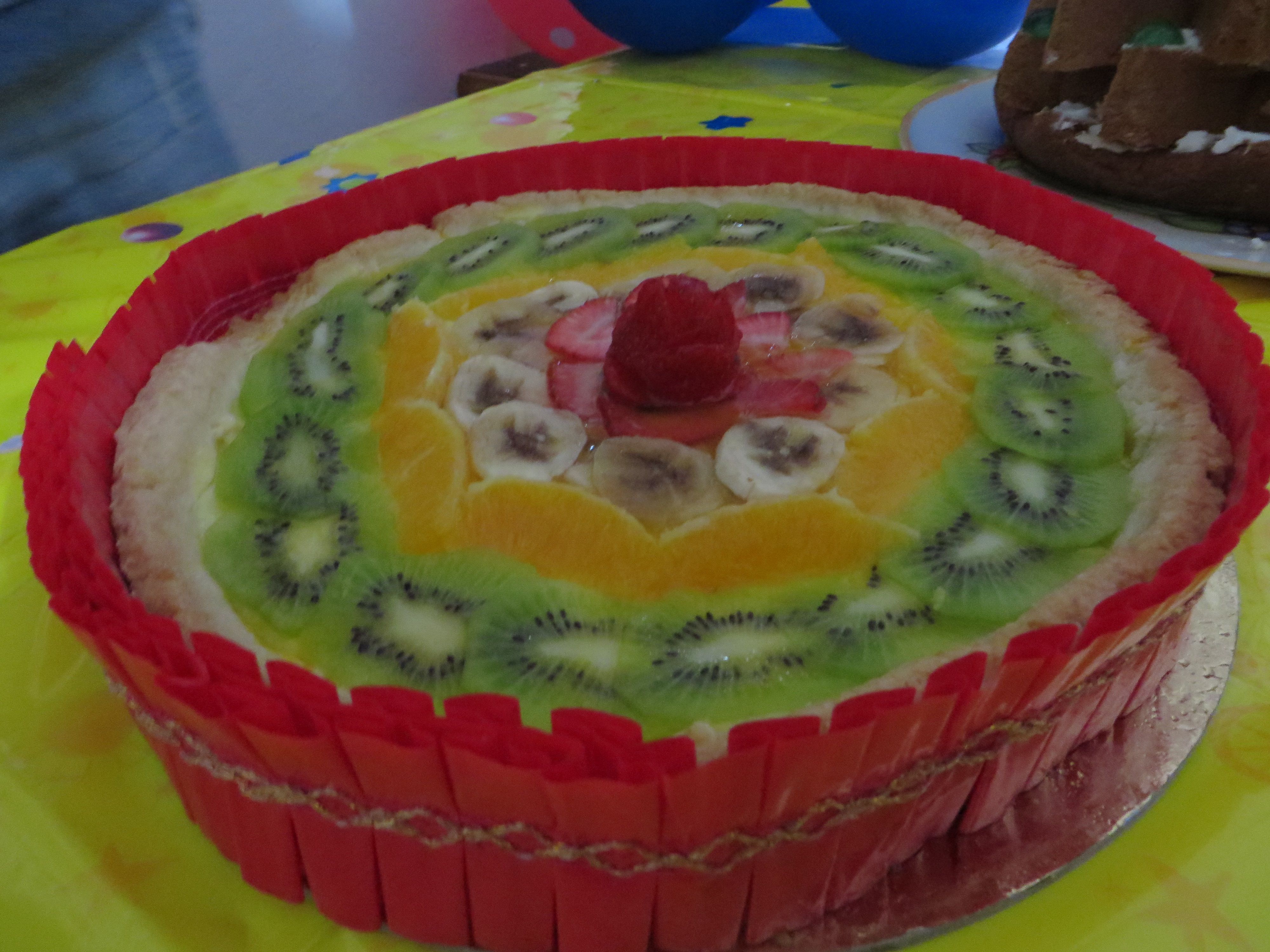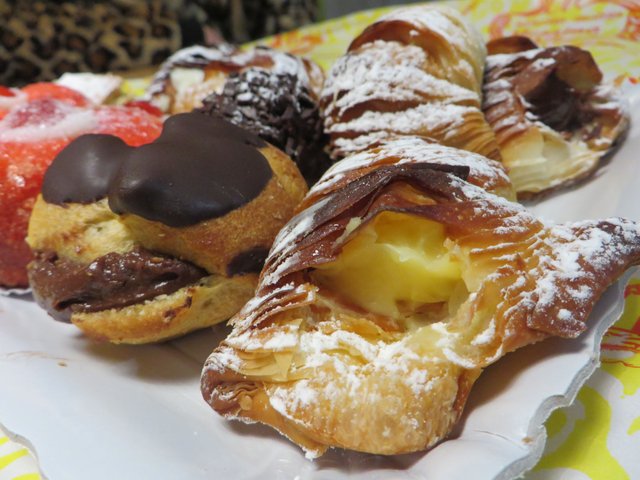Hello world of steemit these period I have not been very active in steemit.For my business trips and I did not always have internet I came back yesterday from Sicily and I talk about the Sicilian pastry.
There are three sources of Sicilian cuisine in terms of desserts: the first is the peasant environment, where it was up to the women in the approach of each religious and family festival, to prepare the desserts provided for such recurrences. The second source is linked to the monasteries, where the cloistered nuns prepared, inventing them from time to time, rich and imaginative sweets, which are handed down until today, exclusively within the walls of the convents. The third source is, finally, the most recent acquisition and concerns the refined confectionery imported into Sicily by the skilled Swiss confectioners, who moved from the beginning of the century to the island. In fact, the best known Sicilian desserts are those belonging to the Swiss-Sicilian confectionery, which is found in all the major cities of Italy. Among the many dominations that have occurred on the island, it is certainly the Arab one that has more impressed its own imprint, because it has introduced some elements, such as pistachio, cinnamon, sugar, almond paste, granita, which is widely used in the preparation of many Sicilian sweets
But it is through creativity that traditional Sicilian confectionery turns out to be rich and varied, even when it uses simple and poor ingredients: ciaurrina, an ancient traditional dessert, has honey as its sole ingredient.
Each province of Sicily preserves its tradition in terms of desserts, as well as for every popular, religious and family festival. Easter and the Commemoration of the Dead are the most celebrated holidays on the island. The holy week, so much felt in all of Sicily, also becomes the occasion to prepare a variety of sweets and ritual breads, linked to the religious meaning of Easter, elaborated with the same uses that are part of the agro-pastoral tradition, present not only in the history of Sicily but in that of the Mediterranean peoples. The ritual breads, made from flour, eggs, sugar, real pasta and ricotta, are real specialties that are given different forms based on religious symbolic references. A sweet of Arabic origin, made with ricotta and real pasta decorated with candied fruit, cassata, is a real masterpiece of goodness and beauty, tasty like no other, become over time an Easter cake, even if today it is found all the year. Other typical sweets of the Easter period are the pecorelle of real pasta and cassateddi, common in Ragusa.
For the commemoration of the dead, which in Palermo takes on a meaning of celebration that mainly involves children, who receive for that day toys and sweets, are prepared the famous "sugar puppets", which depict the ancient paladins and knights, and the fruit of real pasta, called Martorana, from the homonymous convent of Palermo where the cloistered nuns prepared them. Today it is usual to see, in the windows of pastry shops, trays with martorana fruit, shaped by skilled pastry chefs.

Some sweets are prepared only at certain times of the year or for certain patronal holidays. December 13th in Palermo is a widespread tradition, especially among the palermitani devoted to St. Lucia, do not eat bread and pasta during the day, but the cuccìa, a cake made with boiled corn and ricotta. For the feast of St. Peter (June 29) are prepared giant cookies in the shape of a key, and for St. Martin (November 11) biscuits in the form of loaves, filled with ricotta cream. For St. Joseph (March 19), celebrated throughout the island, the typical sweets are the sfinci, which depending on the city or country in which it is celebrated, are prepared in a different way. At Christmas, the most popular desserts are the buccellato, a large donut filled with dried and candied fruit, the nucatoli, the mustazzoli, the petramennula (or nougat).
The ice creams and sorbets deserve special mention, in the most varied tastes, such as sponges, froths, cassata and frozen cakes, real triumphs of taste and flavor, which are part of one of the most renowned confectionery traditions. During the summer season, it is a widespread habit from morning to breakfast and during the day, to consume the granita, with or without cream, accompanied by brioche. The granita, sweet of Arabic origin that derives from the sorbetto, is prepared in the tastes to the fruit, coffee, chocolate, milk of almond and jasmine. In the last centuries, the granita was served in the great banquets of the nobles, between a dish and the other, to facilitate the ingestion of more elaborate dishes, and this habit has remained even today in the most important lunches

Ciao mondo di steemit in questi periodi non sono stato molto attivo in steemit.Per i miei viaggi di lavoro e non ho sempre avuto internet sono tornato ieri dalla Sicilia e parlo della pasticceria siciliana
Ci sono tre fonti di cucina siciliana in termini di dessert: il primo è l'ambiente contadino, per preparare i dessert previsti per tali ricorrenze. La seconda fonte è legata ai monasteri, dove vengono preparate le monache di clausura, inventandole di volta in volta e dolci fantasiosi, che vengono tramandati fino ai giorni nostri. La terza fonte è, infine, la più recente acquisizione e riguarda la raffinata pasticceria in Sicilia dagli abili pasticceri svizzeri, che si spostarono dall'inizio del secolo fino all'isola. Infatti, i dolci siciliani più conosciuti sono quelli appartenenti alla pasticceria svizzero-siciliana, che si trova nelle principali città d'Italia. È certamente quello arabo che ha maggiormente impressionato la propria impronta, perché ha introdotto alcuni elementi, come il pistacchio, la cannella, lo zucchero, la pasta di mandorle, la granita, che è ampiamente utilizzata nella preparazione di molti dolci siciliani

È attraverso la tradizionale pasticceria siciliana che si rivela ricca e variegata, anche quando utilizza ingredienti semplici e poveri: la ciaurrina, un dolce tradizionale antico.

Ogni provincia della Sicilia conserva la sua tradizione in fatto di dessert, così come per ogni festival popolare, religioso e familiare. La Pasqua e la commemorazione dei morti sono le feste più celebri dell'isola. La settimana santa, con l'occasione di preparare una varietà di dolci e pani rituali, legati al significato religioso della Pasqua, con gli stessi usi che fanno parte della tradizione agro-pastorale non solo nella storia della Sicilia ma in quella del Popoli mediterranei. I pani rituali, fatti di farina, uova, zucchero, vera pasta e ricotta, sono vere e proprie specialità che sono forme diverse basate su riferimenti simbolici religiosi. Un dolce d'origine araba, fatto con ricotta e vera pasta con frutta candita, la cassata, è un vero capolavoro di bontà e bellezza, gustoso come nessun altro, diventa nel tempo un dolce pasquale, anche se oggi è tutto l'anno. Altri dolci tipici del periodo pasquale.
Per i bambini, che ricevono per quel giorno giocattoli e dolci, vengono preparati i famosi "burattini di zucchero", che ritraggono gli antichi paladini e cavalieri, e il frutto della vera pasta, detta Martorana, dall'omonimo convento di Palermo dove si preparavano le suore di clausura loro. Oggi è normale vedere, nelle vetrine delle pasticcerie, modellate da abili pasticceri.

Alcuni dolci sono preparati solo in determinati periodi dell'anno o per alcune feste patronali. Il 13 dicembre a Palermo è una tradizione diffusa, soprattutto tra i palermitani devoti a Santa Lucia, ma non il pane, ma una torta fatta con mais bollito e ricotta. Per la festa di San Pietro (29 giugno) biscotti di panpepato a forma di chiave, e per San Martino (11 novembre) biscotti a forma di pani, ripieni di crema di ricotta. Per San Giuseppe (19 marzo), celebrati nell'isola, i dolci tipici sono gli sfinci, che a seconda della città o paese in cui viene celebrato, vengono preparati in modo diverso. A Natale, i dolci più popolari sono il buccellato, la senape, la petramennula (o il torrone).
Meritano una menzione speciale i gelati e i sorbetti, come spugne, spuma, cassate e torte congelate, veri trionfi di gusto e sapore, che sono una delle più rinomate tradizioni dolciarie. È un'abitudine diffusa dalla mattina alla colazione e durante il giorno, per consumare la granita, con o senza panna, accompagnata da brioche. La granita, dolce dal sorbetto, è preparata nei gusti alla frutta, al caffè, al cioccolato, al latte di mandorla e al gelsomino. Negli ultimi secoli la granita veniva servita nei grandi banchetti dei nobili, per facilitare l'ingestione di piatti più elaborati, e questa abitudine è rimasta anche nei pranzi più importanti